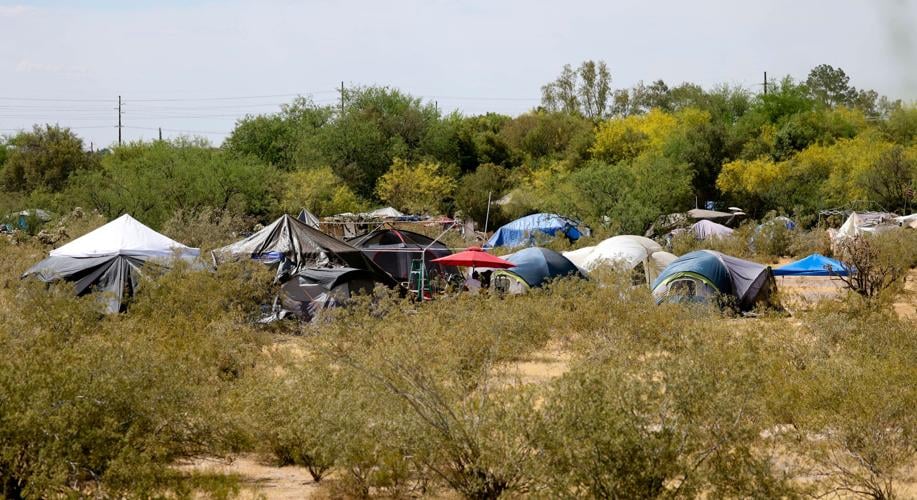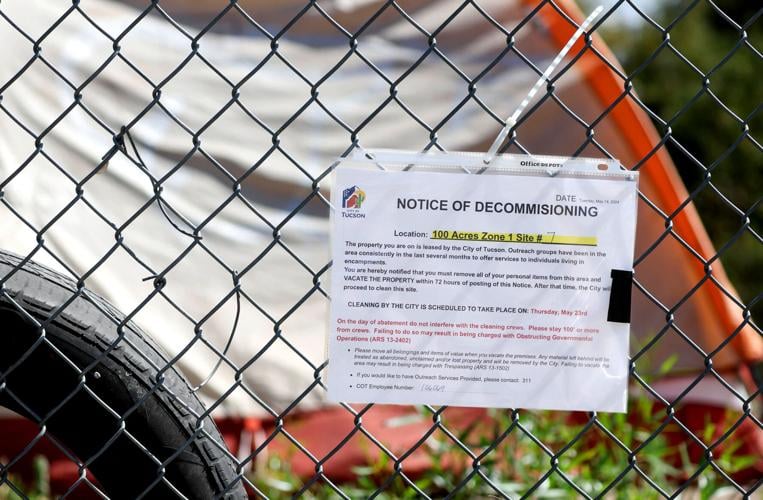People living in a portion of Tucson’s largest homeless encampment have been given a 72-hour notice from the city to begin clearing the area, authorities say.
The 100-Acre Wood, often called “The Acres” is located near the Davis-Monthan Air Force Base and has become Tucson’s largest homeless encampment.
That, however, could begin changing as early as Friday.
The clear-out notice was given Tuesday to those living in the northern portion of The Acres, on the north side of East Golf Links Road where it meets South Alvernon Way, said Andy Squire, a spokesman for the city.
That strip, called Zone 1 by city officials, will be cleared out so that D-M can begin underground testing for PFAS chemicals, as previously reported by the Star’s Tim Steller.
As of Tuesday, there were 19 “sites” and about 24 people currently living in Zone 1, according to Mari Vasquez, who coordinates the city and county’s homeless response.
The clear-out notice likely is the first round of what could be a larger clearing of The Acres as the city prepares to renovate the area’s mountain biking trails.
The Sonoran Desert Mountain Bicyclists constructed the original trails on the city-leased land and has since raised $28,000 , plus $116,000 from Trek to build new trails on the land. The state of Arizona has also given a grant of $170,000 for the project. The city is putting $27,000 toward it.
By Friday, folks living in the northern strip of The Acres must begin clearing out. Once that deadline passes, however, it doesn’t mean that anyone still living in Zone 1 will face consequences immediately, Squire said.
“The goal is to get people connected with the housing that they need and the services they need to get into sustainable real humane housing,” he told the Star. Most likely, he said, the city will approach the prospect of clear-outs “on a case-by-case basis” depending on the circumstances of individuals in Zone 1.
“Those postings can go from 72 hours to 14 days, so right now we are in the process of figuring out departments and when-who can show up, things like that,” Vasquez said. “So, you know, it could come as early as Friday and as late as 14 days, and then (longer) if we need to post again.”
If people refuse to leave, the city will look to the Tucson Police Department to assist in clearing individuals out, but Vasquez says that they are “definitely the last department that we will go to.”
“We have really tried to turn the service model into providing services first (and) telling people what their choices are. They do have a choice,” she said. “This is not a TPD-driven process …. But if (people) decide to not leave and stay there, then there are consequences, and that’s where the enforcement will come in.”
Once the area is clear, the city’s Environmental Services department will begin cleaning the area. That process “will be a little trickier” than usual since they’ll have to refrain from “disturbing some of the soil so groundwater testing can be done,” Vasquez said.
As of late-April, at least 70 people have moved from the broader encampment into emergency housing and detox programs over the last several years. Vasquez said Wednesday that nobody has taken up the offer since then.
For the roughly two dozen people currently living in Zone 1, the city “absolutely” has the capacity for all these people if they choose to take up the offers of emergency housing or detox services, Vasquez told the Star.
Although the city has plans to clear-out the entire park by the end of the year, Squire said “there’s not a hard timeline” as of right now.
“That’s going to be a longer process because there’s not an ultimate rush to do the bike path,” Squire said. “It could be sooner than (the end of the year) … but again, that’s all fluid.”





